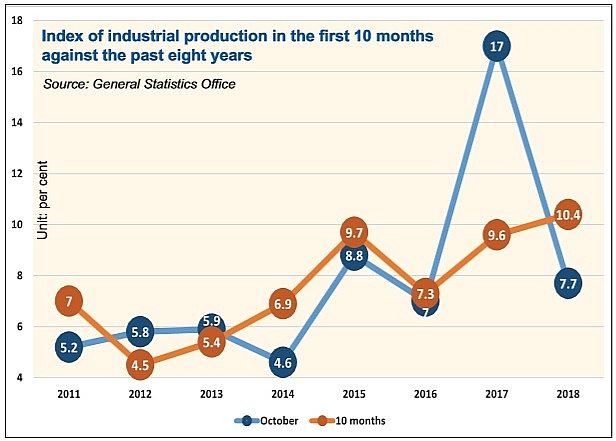Conditions improve for industrial sector
 |
The General Statistics Office (GSO) last week reported that the economy’s index for industrial production (IIP) rose by 10.4 per cent in the first 10 months of this year, the highest rise since 2011, when the 10-month IIP rate climbed 7 per cent on-year (see chart).
“The IIP is on a strong uptrend, reflecting the fact that a more business friendly climate has been created. Enterprises have been finding it more convenient to perform in Vietnam,” said GSO head Nguyen Bich Lam.
In industrial production, the manufacturing and processing sector, which creates 80 per cent of Vietnam’s industrial growth, rose 12.7 per cent on-year, while the production and distribution of electricity climbed 9.6 per cent on-year. One of the key contributors to 10-month IIP growth is Taiwanese steelmaker Formosa Ha Tinh Steel Corporation (FHS) in the central province of Ha Tinh.
“The 10-month IPP growth of all 63 cities and provinces nationwide has increased on-year. However, Ha Tinh’s IIP growth has been the highest at 105.6 per cent on-year, largely thanks to contributions from FHS, followed by Thanh Hoa province (up 30.3 per cent on-year) owing to the $9 billion Nghi Son refinery and petrochemical complex, which came into operation on a trial basis in mid-2018,” said a GSO report released last week.
In the first seven months of this year, FHS produced 1.9 million tonnes of hot iron and is expected to reach the goal of five million tonnes in 2018. With the full capacity of the second blast furnace, its annual production output is expected to reach 6.71 million tonnes with sales revenue reaching $3.5 billion.
Pham Van Can, director of Van Phu An JSC which specialises in producing garments and textiles in the northern province of Hai Duong, told VIR that in the first 10 months of this year, his company’s total production value increased by 23 per cent on-year to about $8.5 million, with export turnover ascending 20 per cent on-year.
“The economic situation is getting far better than in previous years. We have been benefiting from the government’s more pro-business policies since early last year,” Can said. “The time for us to conduct customs clearance has also been reduced by 30 per cent on-year.”
This company’s optimism is also reflected in the GSO’s figures showing that the production of local textiles and garments has witnessed an on-month increase of 18.1 per cent in October and 12.2 per cent in the first 10 months.
The production of many other industrial products has enjoyed high on-year growth, such as petrol (47.4 per cent), steel (40.5 per cent), TV sets (26.3 per cent), liquefied natural gas (24.6 per cent), aluminum (23.5 per cent), cloth from artificial fibres (21.4 per cent), mobile phone spare parts (18.8 per cent), and aquatic feed (17.2 per cent).
However, notably, unlike during the same period last year, the production of mobile phones since early this year has reduced by 3 per cent on-year. South Korea’s Samsung contributes most to the production of mobile phones in Vietnam. In the same period last year, the output of this product rose by 4 per cent on-year.
According to the government, the economy will reach its 6.7 per cent growth target this year, thanks to on-year strong growth in the economy’s key sectors. This includes the agro-forestry-fishery, up 3.3 per cent – a fourfold increase against 2016 to hit a record $41 billion in export turnover; industry and construction (up 7.59 per cent); and services (up 7.35 per cent – the highest since 2008).
What the stars mean:
★ Poor ★ ★ Promising ★★★ Good ★★★★ Very good ★★★★★ Exceptional
Related Contents
Latest News
More News
- Global alliance develops $1 billion AI data centre network in Vietnam (December 30, 2025 | 10:08)
- Businesses ramp up production as year-end orders surge (December 30, 2025 | 10:05)
- Vietnam’s GDP forecast to grow by 9 per cent in 2026 (December 29, 2025 | 08:29)
- Vietnam's top 500 value-creating enterprises announced (December 27, 2025 | 08:00)
- Three-way partnership unveiled to ease financing at Hong Hac City (December 24, 2025 | 14:13)
- PM orders investment model for North–South high-speed rail (December 22, 2025 | 17:43)
- First members of Danang International Finance Centre revealed (December 22, 2025 | 17:39)
- Securing capital and efficiency for Vietnam’s 2026-2030 growth ambitions (December 17, 2025 | 10:00)
- Driving double-digit growth through green and circular transformation in Vietnam (December 17, 2025 | 09:00)
- Vietnam bucking trend in the global M&A landscape (December 16, 2025 | 14:20)

 Tag:
Tag:




















 Mobile Version
Mobile Version